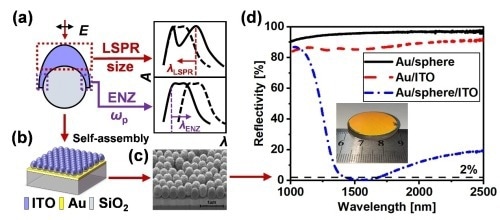Reviewed by Alex SmithJun 21 2022
A design idea for a tunable broadband perfect absorber based on non-split coupling of Epsilon-near-zero (ENZ) and localized surface plasmon resonance (LSPR) modes was recently put forth by scientists from the Shanghai Institute of Optics and Fine Mechanics (SIOM) of the Chinese Academy of Sciences.
 Figure 1. (a). Schematic diagram of the excitation unit of the ITO semi-ellipsoid shell and the realization principle of the tunable absorption band; (b). Schematic diagram of the structure of the broadband perfect absorber; (c). Microscopic topography of the cross-section of the device; (d). Reflectance spectrum and picture of the device. Image Credit: Shanghai Institute of Optics and Fine Mechanics.
Figure 1. (a). Schematic diagram of the excitation unit of the ITO semi-ellipsoid shell and the realization principle of the tunable absorption band; (b). Schematic diagram of the structure of the broadband perfect absorber; (c). Microscopic topography of the cross-section of the device; (d). Reflectance spectrum and picture of the device. Image Credit: Shanghai Institute of Optics and Fine Mechanics.
To trigger spatially separated ENZ and LSPR modes, the scientists have created a sub-wavelength single-layer Indium Tin Oxide (ITO) ellipsoidal shell array. This array successfully attained more than 98% light absorption in the region of 1,435–1,680 nm.
Low-cost self-assembly technology was used to create a centimeter-level absorber with polarization-independent, wide-angle, and controllable resonant absorption. In Applied Surface Science, similar findings were published.
Several linear and nonlinear optical applications depend on optical absorption. Planar ENZ materials have recently offered practical answers for a range of narrowband, wideband, and adjustable ideal absorbers.
Furthermore, there are severe polarization dependence and oblique incidence issues with planar ENZ materials for complete absorption, which restricts their use. The polarization and angle dependence issues mentioned above are believed to be resolved by combining ENZ films with metasurfaces.
The device size is, however, restricted to the order of hundreds of microns by the disclosed metasurface approaches, which often call for intricate designs, multi-step manufacturing, and expensive FIB or EBL processes.
In this study, the researchers put forth a broadband ideal absorber design based on ENZ films with a semi-sphere pattern. The main goal of the perfect absorber is to achieve broadband perfect absorption by using the special ultrathin film and nanoparticle properties of the semi-ellipsoidal shell ENZ film to stimulate spatially distinct ENZ and LSPR resonance modes.
According to the scientists, the absorber’s special structural symmetry allows it to display polarization-independent and wide-angle characteristics, and the active tunability of ENZ materials gives it tunability.
Additionally, the ideal absorber is suitable with self-assembly technology, making it possible to produce devices at a low cost that are wafer — or centimeter-scale.
The ideal absorption scheme suggested in this study, in relation to being applicable to ITO material, is also relevant to other ENZ materials with both ENZ and plasmon characteristics, like cadmium oxide (CdO), ZnO: Al (AZO), titanium nitride (TiN), etc. This makes it possible to realize broadband perfect absorption in a wider range of wavelengths.
Journal Reference:
Jiang, J., et al. (2022) Polarization-Independent, tunable, broadband perfect absorber based on semi-sphere patterned Epsilon-Near-Zero films. Applied Surface Science. doi.org/10.1016/j.apsusc.2022.153551.